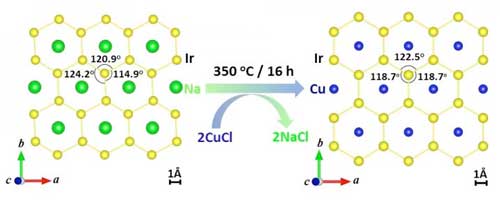| Posted: Oct 24, 2017 |
A quantum spin liquid
(Nanowerk News) Researchers from Boston College and Harvard have created an elusive honeycomb-structured material capable of frustrating the magnetic properties within it in order to produce a chemical entity known as "spin liquid," long theorized as a gateway to the free-flowing properties of quantum computing, according to a new report in the Journal of the American Chemical Society ("Cu2IrO3: A New Magnetically Frustrated Honeycomb Iridate").
|
|
The first-of-its-kind copper iridate metal oxide - Cu2IrO3 - is one where the natural magnetic order is disrupted, a state known as geometric frustration, said Boston College Assistant Professor of Physics Fazel Tafti, a lead author of the study, titled Cu2IrO3: a new magnetically frustrated honeycomb iridate.
|
 |
| Scientists from Boson College and Harvard turned to copper to create a first-of-its-kind iridate -- Cu2IrO3 -- where the natural magnetic order is disrupted, a state known as geometric frustration. (Image: Boston College) (click on image to enlarge)
|
|
The copper iridate is an insulator - its electrons are immobilized in the solid - but they can still transport a magnetic moment known as "spin". The transport of free spins in the material allows for a flow of quantum information.
|
|
The Kitaev model, proposed in 2006 by Cal Tech Professor of Physics Alexei Kitaev, states that a hexagonal honeycomb structure offered a promising route to geometric frustration and therefore, to quantum spin liquid.
|
|
Only two honeycomb lattice have been successfully developed in an attempt to fulfill Kitaev's model: a lithium iridate (Li2IrO3) and a sodium iridate (Na2IrO3). Yet both fell short of achieving an ideal spin liquid due to magnetic ordering, said Tafti, who co-authored the paper with Boston College post-doctoral researchers Mykola Abramchuk and Jason W. Krizan, BC Adjunct Professor of Chemistry and Director of Advanced Chemistry Laboratories Kenneth R. Metz, and Harvard's David C. Bell and Cigdem Ozsoy-Keskinbora.
|
|
Tafti and his team turned to copper due to its ideal atomic size, which is between lithium and sodium. Their studies in x-ray crystallography found subtle flaws in the honeycombs formed in the lithium and sodium iridates. The team swapped copper for sodium in what Tafti termed a relatively simple "exchange" reaction. The effort produced the first oxide of copper and iridium, Tafti said.
|
|
"Copper is ideally suited to the honeycomb structure," said Tafti. "There is almost no distortion in the honeycomb structure."
|
|
A decade after the original prediction of quantum spin liquid on a honeycomb lattice by Kitaev, the young team of scientists from Boston College succeeded in making a material that almost exactly corresponds to the Kitaev model, Tafti said.
|
|
Tafti's lab will pursue the "exchange" chemistry path to make new forms of honeycomb materials with more exotic magnetic properties, he said.
|

